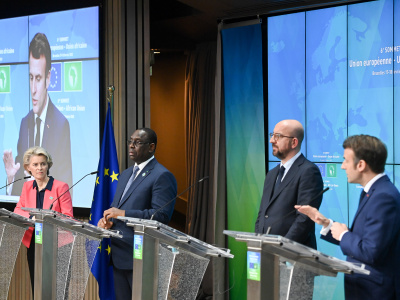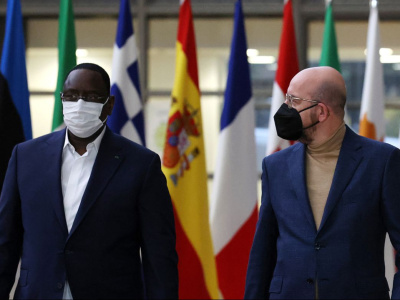
Breaking down the EU-AU Summit – Weekly Compass editorial
In a special EU-AU Summit edition of ECDPM’s Weekly Compass newsletter, Philomena Apiko took over from Virginia Mucchi as guest editor and shared her take on what happened during the EU-AU Summit on 17 and 18 February in Brussels.
Breaking down the summit
Who joined: With 40 AU heads of state and government and all 27 EU leaders attending in person, the summit can be considered a diplomatic success – especially because of its previous postponement due to the COVID-19 pandemic, which is still far from over, and the growing number of other potential partners engaging with Africa.
Who missed the summit: Some African leaders were missing, notably the heads of state and government of Burkina Faso, Guinea, Mali and Sudan; countries which have been suspended from the AU following recent coups. The rules are clear: suspended members cannot participate in any AU activities – including summits.
The end result: A joint vision for a renewed partnership for solidarity, peace and security, sustainable and sustained economic development, and prosperity for both unions’ citizens. The joint declaration has ambitions on a wide number of themes – but as we know, actions speak louder than words. With such a broad array of commitments, will there be sustained political will and funding to accomplish them?
A promising new format
The format of engagement between the leaders was definitely a highlight. At the previous EU-AU Summit in Abidjan, leaders simply came prepared with ready-made speeches. This time around, EU and AU member states co-chaired seven roundtables, following the themes of the summit. In the words of AU Commission chair Moussa Faki Mahamat, this allowed for frank discussions and joint solutions.
Another positive outcome was the agreement to create a follow-up monitoring mechanism to improve transparency and track commitments. In practice, this means that the AU and EU colleges will meet periodically and review the implementation of all commitments made during EU-AU summits and ministerial meetings. This should go a long way in holding both sides to the commitments made and in tracking finance for these commitments. As a side note, it is good to see leaders follow through on this idea, initially proposed during the ministerial meeting in Kigali last October.
Outcomes on health, peace and security, climate and finance
In a conversation with Virginia Mucchi right before the summit, I had shared my hopes for concrete commitments on health, investment and financing for growth, peace and security, and climate change, especially ahead of COP27 in Egypt this year. To a certain extent, discussions on health did result in strengthened commitments on vaccine sharing and technology transfer – but more on that later.
Peace and security centred around a renewed and enhanced cooperation to address common challenges such as instability, radicalisation, violent extremism and terrorism, as well as tackling the root causes of conflicts and addressing the entire conflict cycle through an integrated approach. This is definitely a step up from the EU’s usual narrow focus on peace support operations towards the AU’s focus on early warning and conflict prevention.
Going into the summit, we knew the climate crisis and the green and energy transition were some of the more contentious issues. The challenge of how the green and energy transitions can respond to Africa’s industrialisation and rapid growth ambitions still remains. My colleagues Alfonso Medinilla and Hanne Knaepen discuss in more detail the financing of the just transition and issues around adaptation.
What was disappointing is that not all EU members made concrete commitments to reallocate their portion of special drawing rights (SDRs) to vulnerable countries, including those in Africa, opting to rather reiterate the broad (and vague) voluntary commitment made at the G20 last year. Expectations are for the reallocation of $100 billion from rich countries, an amount that is far from being met. There was also no concrete conclusion on alternative mechanisms for channelling those SDRs outside of the International Monetary Fund (IMF).
Were the expectations of African leaders met?
Given the AU’s priority on health security, the summit did deliver some concrete results for the African side. Immediate support will be tailored towards local and regional mechanisms for procurement, allocation and deployment of medical products, which is essential to vaccinate Africa’s population. The EU reaffirmed its commitment to provide at least 450 million of vaccine doses to Africa, in coordination with the Africa Vaccine Acquisition Task Team (AVATT) platform, by mid-2022. However, it is yet to be seen if this will be honoured, given shortcomings in prior commitments on vaccine sharing.
On the plus side, strengthened commitment was made towards local production of vaccines. Six countries (Egypt, Kenya, Nigeria, Senegal, South Africa and Tunisia) have been chosen for the World Health Organization (WHO)’s mRNA technology transfer hub. This will increase the continent’s capacity to not only manufacture COVID-19 vaccines in the short term, but also scale up the production of vaccines for malaria, tuberculosis, HIV and other diseases. This is definitely the right move towards Africa’s health sovereignty.
On the Global Gateway, although this EU investment package is welcome, questions still remain on the African side on how this will be rolled out in practice. Sceptics have labelled this a repackaging of old funds. With €150 billion set for support to Africa over seven years, the Global Gateway aims to boost public and private investment, including in infrastructure, energy and green transition, digital transformation, growth and jobs, transport, and human development.
Some say this is a bid to compete with China’s Belt and Road Initiative, but its true impact hinges on whether it will sustainably support Africa’s priorities. As a start, it is refreshing to see the joint declaration mentioning that the EU’s support to infrastructure will be aligned to the AU’s Programme for Infrastructure Development (PIDA), but much more is needed for effective implementation. This bucket list of support areas under the Global Gateway will require coordinated efforts and financing to ensure this moves from rhetoric to action. My colleague San Bilal looks at what a balanced investment partnership would entail.
Did the summit mend some of the cracks in the relations, or not really?
There was an attempt to address the contentious issues around the intellectual property waiver at the World Trade Organization (WTO). While leaders didn’t reach a conclusion, they did commit to engage constructively towards an agreement on a comprehensive WTO response to the pandemic, incorporating aspects related to both trade and intellectual property.
Will this represent a shift from the current impasse at the WTO, where AU and EU countries sit on opposite sides of the waiver discussion? The EU has proposed the use of compulsory licensing as a possible bridge, but we are yet to see what the compromise will be by spring this year. What is clear, as stated by South African president Cyril Ramaphosa, is that the profitability of pharmaceutical companies should not be placed above human lives.
On migration and mobility, leaders made commitments on preventing irregular migration, tackling human smuggling and trafficking, stronger border management and more effective policies on return, readmission and reintegration, including on promoting voluntary return. A passing mention was made on pathways for legal migration opportunities to be further developed between both continents and within Africa, with no concrete proposals. Nothing we haven’t heard before, really. What was missing from the summit was innovative ways to address the continued divergences around migration (like the ones my colleagues Amanda Bisong and Anna Knoll proposed in this commentary right before the summit).
What next?
A common thread from the summit, also reflected in the joint declaration, was the commitment to multilateralism, which may be a concrete way to deepen the partnership. Most of the issues discussed at the summit, be it on health, the intellectual property waiver, climate change, peace and security or SDRs, require collaboration in global fora like the WHO, the WTO, the UN Framework Convention on Climate Change, the UN Security Council and the IMF. How joint positions by the EU and AU member states will be undertaken in the future, remains to be seen.
The role of young people, civil society, the private sector and local authorities needs to be solidified in the partnership. Ahead of the summit, these groups were given a platform to discuss AU-EU relations through the Africa-Europe Week and the EU-Africa Business Forum, but their role after the summit is less clear. Perhaps there is a role for them in the new follow-up monitoring mechanism, to track commitments made by the leaders and ensure that the benefits of the partnership become real for ordinary citizens in both continents.
Here’s to hoping leaders follow through on the commitments made in Brussels last week.
The views are those of the author and not necessarily those of ECDPM.




